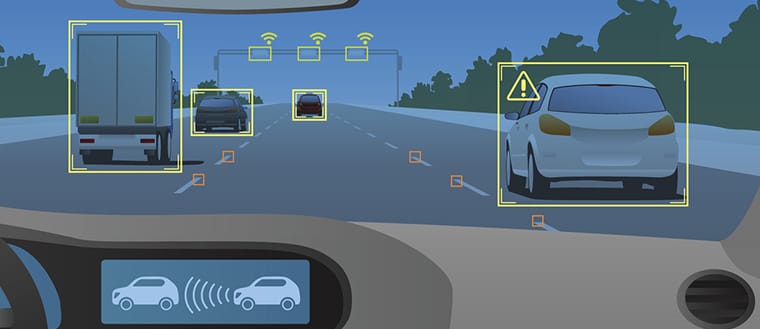Self-driving cars: a number of people consider it to be science fiction, while others are confident that the technology is just around the corner, if not already present in many ways. But how far away are we really from experiencing this technology in day-to-day life?
In order to figure out how far away we are from driverless cars filling our streets, it’s important to first consider the definition of a driverless car, which is: ‘a robotic vehicle that is designed to travel between destinations without a human operator.’
While we might not be at that point with commercial vehicles at this stage, we do have a number of car features which come into the ‘driverless’ category. These features can be grouped into one of two groups; passive or active.
Passive Automated Technologies
Passive technologies are the major innovations we have seen to improve the ease of vehicle operation and use technology to fulfil a role which we, as humans, have previously had to put more effort in to complete. These include, but are not limited to:
– Reverse parking sensors
– Lane departure warning systems
– Blind spot monitoring systems
These technologies have been found to be particularly useful to some drivers, however the driver still needs to be very conscious and aware of the systems and how to use them in order to make rational decisions on the road. These systems are replacing certain human efforts but are acting as warning triggers to the human driver, rather than taking over and making decisions to directly influence the vehicle’s controls.
Active Automated Technologies
Active technologies are different in the sense that while they also replace certain human efforts, they are integrated into the vehicle to a point where they are able to directly influence the controls of the vehicle. This means that the systems are able to identify the task they are set and then react accordingly with control over a certain component in the vehicle. Examples of these include:
– City stop: a system to increase fuel efficiency whereby the vehicle recognises when the it is stationary and responds by shutting off power to the engine temporarily, only to restart the engine once the accelerator is used.
– Parking assist: systems which utilise sensor technology and cameras to create an actionable path to park a vehicle. The system has control over steering, acceleration and gears in order to complete the task.
– Adaptive cruise control: a cruise control system which adjusts the vehicle speed based on the speed of the vehicle ahead rather than set by a human operator as traditional cruise control systems have operated.
– Collision avoidance system: a safety mechanism designed to reduce the severity of a collision. The system uses radar and camera technology to detect an imminent crash and the system responds by braking, steering away from the danger, or both.
– Lane departure warning system: a mechanism designed to prevent a vehicle from moving out of its lane on motorways and arterial roads. This occurs due to driver error, distractions and drowsiness, which is why this technology is designed to alert the driver and if no action is taken, automatically steer the vehicle to stay in the lane.
If you’re looking to buy a car, these technologies are already seen in a number of commercial and passenger vehicles available for purchase today. If you are looking for a vehicle with such features, you should consider contacting a car broker to discuss the options and reliability of the technologies available. The presence of these systems show that there are a number of intelligent automated technologies which are paving the way for a completely driverless car in the near future.
The Verdict
It’s important to note that the technologies mentioned have not been integrated without issues. A number of incidents have occurred when these technologies have been tested in a practical environment, which suggests that perhaps we are not completely there yet with being able to trust and rely on technology 100% for all systems. It’s also important to note that these are individual systems in a vehicle still controlled by a human operator who has the option to override them.
A completely driverless vehicle must integrate all of these systems, plus many more, into a single system which controls all aspects of driving without human input. There have been many examples of these types of vehicles – Tesla, Volvo, Ford, Nissan, Google, Renault, Peugeot and other car manufacturers have all given it a go. Some of these companies have even trialled their driverless cars on the road which have been successful. The feedback from the general public from hearing such success stories has filled many with confidence as to just how close we are to having driverless cars available for purchase.
Back in 2017 federal parliamentary inquiry, the mayors of Australia’s capital cities have said they expect driverless cars to be safely integrated onto the roads with traditional traffic between 2020 and 2025. While this is promising and a shared prediction from many around the world, there is still a lot of discussion which needs to take place surrounding the legal, moral and financial side of driverless vehicles.
Whatever the case, there’s something that most can definitely agree on – driverless cars are on the horizon and are set to shake up the industry when they do arrive.
